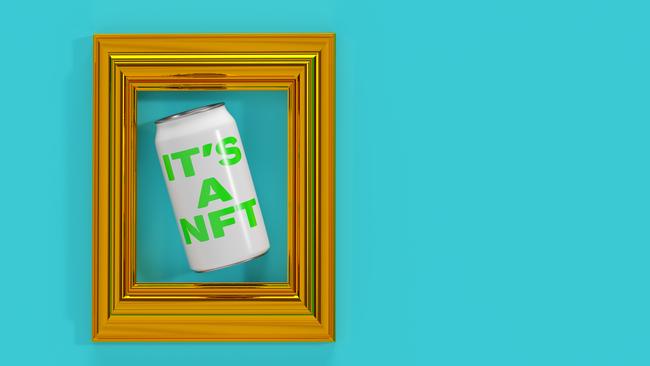Here’s your guide to those non-fungible tokens
How will I engage with the market? What does the future hold? It’s all here. Story by Pavel Kireyev and Peter C. Evans

Non-fungible tokens may seem like a passing craze, but with more than $US10bn ($14bn) traded in the third quarter of 2021 alone, it has become clear that this emerging technology – a blockchain-based tool that enables anyone to monetise digital content – is growing into a major industry. In March last year, musician 3LAU collaborated with crypto start-up Origin Protocol to create a specialised platform to sell his new album as an NFT, where it ultimately sold for $US11.6m. Visual artist Beeple famously sold a tokenised digital artwork for $US69m through Christie’s auction house, and the NBA’s Top Shot, which is owned by crypto platform Dapper Labs and enables fans to buy and sell tokenised video clips of basketball game highlights, has generated more than $US715m in transaction volume.
In contrast to platforms such as Spotify and Netflix, which provide unlimited digital content for a subscription fee, NFT platforms are built around the idea that just like physical content, digital content too can be scarce and therefore can be meaningfully owned and traded. These platforms leverage blockchain technology to verify the provenance of digital content, similar to how a traditional auction house might verify that a given work of art is in fact the original and not a replica.
WHAT KINDS OF MARKETPLACES?
While there are numerous factors to consider, we’ve found it can be particularly helpful to characterise NFT marketplaces on a spectrum from streamlined to augmented. Streamlined marketplaces support a broader range of NFTs and offer more limited, generic services to sellers, while augmented marketplaces are highly specialised and provide a more full-service experience. Streamlined platforms include services such as OpenSea and Rarible, which host auctions and fixed-price sales for a wide variety of NFTs and more closely resemble traditional platforms such as eBay, Etsy or Mercari. These marketplaces focus predominantly on enabling efficient transactions, often providing payment infrastructure to accept credit cards and crypto payments in bitcoin, ethereum and occasionally other specialty tokens. They offer minimal additional services and, because of their breadth, these platforms generally have fairly large and varied user bases.
Augmented marketplaces, on the other hand, tend to focus on narrower niches and offer numerous value-added services such as minting, marketing, curation, pricing recommendations, portfolio trackers and even full-blown games built on top of the NFTs. For example, the NBA’s Top Shop focuses on basketball collectibles that the platform packages and markets, SuperRare focuses on visual art and provides extensive curation services, and Sorare hosts fantasy soccer competitions.
HOW CAN I ENGAGE WITH THE MARKET?
Companies with a large pool of intellectual property and a target audience within a specific domain may find it beneficial to partner with an augmented platform. A larger quantity of monetisable content generally means a larger upfront investment is more likely to pay off, and these specialised platforms can draw on their niche experience to ensure a successful launch and drive additional value through secondary tools and services.
In addition, some augmented platforms offer detailed data analytics about when other NFTs on the market were minted, how many NFTs competitors are minting, average prices, sales numbers and more. Firms can then use this data to make informed choices about how they mint and price their own digital offerings. For example, NBA Top Shot offers a detailed analytics page for each NFT that includes a breakdown of related market activity, ownership history and other information about the video highlight. Similarly, electronic music marketplace RCRDSHP presents users with extensive analytics on both individual NFTs and on the overall state of the market. Although these industry-specific platforms may have narrower reach, they can be extremely effective within a given market – Sorare, for example, generated nearly $US20m in transaction volume last month and more than $US100m in the past year.
WHAT WILL THE FUTURE HOLD?
At this point you may be asking yourself which of these many platforms is likely to emerge as the Amazon-like industry standard. Traditional marketplaces tend to exhibit winner-takes-all dynamics, meaning that once a single platform achieves scale, it becomes nearly impossible for competitors to overtake it – and so it’s only natural to be concerned about investing in a platform that won’t be made obsolete. However, in contrast to traditional markets, we believe no single NFT platform is likely to assume such a dominant position. There are two key reasons for this.
First, NFT markets are inherently more open than their traditional counterparts. Since NFTs are built on fully public blockchain infrastructure, most transaction data is publicly available, limiting the extent to which these platforms can build the kinds of data moats that lead to monopolies. In addition, the success of augmented platforms suggests that differentiation is highly valuable to both buyers and sellers.
We’re already seeing that there’s strong demand for multiple coexisting NFT marketplaces, each focused on a different domain and offering specialised tools to help their partners succeed. Even within industries, multiple platforms can coexist, as long as they differentiate in the tools and experiences that they provide. For example, one NFT art platform might specialise in minting functionality while another might focus on gaming experiences built on top of art NFTs.
So, if you’re a creator, don’t feel like you have to wait for the Amazon of NFTs to emerge. Evaluate the marketplaces that are currently available based on how well they fit with your unique offerings and business needs, and if you find one that seems well-suited for you, go ahead and dip in a toe.
Pavel Kireyev is an assistant professor of marketing at INSEAD. Peter C. Evans is the managing partner at the Platform Strategy Institute.


